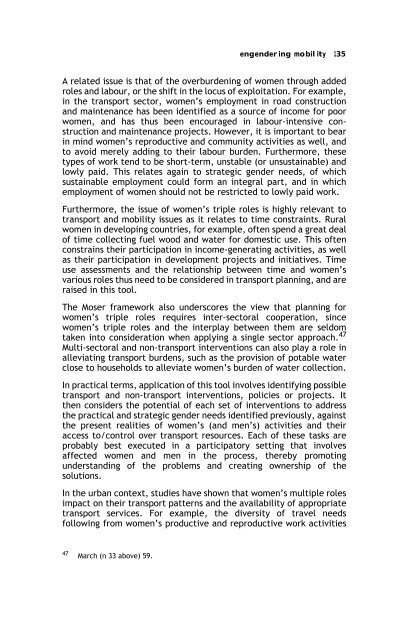Sex, Gender, Becoming - PULP
Sex, Gender, Becoming - PULP
Sex, Gender, Becoming - PULP
Create successful ePaper yourself
Turn your PDF publications into a flip-book with our unique Google optimized e-Paper software.
engendering mobility 135<br />
A related issue is that of the overburdening of women through added<br />
roles and labour, or the shift in the locus of exploitation. For example,<br />
in the transport sector, women’s employment in road construction<br />
and maintenance has been identified as a source of income for poor<br />
women, and has thus been encouraged in labour-intensive construction<br />
and maintenance projects. However, it is important to bear<br />
in mind women’s reproductive and community activities as well, and<br />
to avoid merely adding to their labour burden. Furthermore, these<br />
types of work tend to be short-term, unstable (or unsustainable) and<br />
lowly paid. This relates again to strategic gender needs, of which<br />
sustainable employment could form an integral part, and in which<br />
employment of women should not be restricted to lowly paid work.<br />
Furthermore, the issue of women’s triple roles is highly relevant to<br />
transport and mobility issues as it relates to time constraints. Rural<br />
women in developing countries, for example, often spend a great deal<br />
of time collecting fuel wood and water for domestic use. This often<br />
constrains their participation in income-generating activities, as well<br />
as their participation in development projects and initiatives. Time<br />
use assessments and the relationship between time and women’s<br />
various roles thus need to be considered in transport planning, and are<br />
raised in this tool.<br />
The Moser framework also underscores the view that planning for<br />
women’s triple roles requires inter-sectoral cooperation, since<br />
women’s triple roles and the interplay between them are seldom<br />
taken into consideration when applying a single sector approach. 47<br />
Multi-sectoral and non-transport interventions can also play a role in<br />
alleviating transport burdens, such as the provision of potable water<br />
close to households to alleviate women’s burden of water collection.<br />
In practical terms, application of this tool involves identifying possible<br />
transport and non-transport interventions, policies or projects. It<br />
then considers the potential of each set of interventions to address<br />
the practical and strategic gender needs identified previously, against<br />
the present realities of women’s (and men’s) activities and their<br />
access to/control over transport resources. Each of these tasks are<br />
probably best executed in a participatory setting that involves<br />
affected women and men in the process, thereby promoting<br />
understanding of the problems and creating ownership of the<br />
solutions.<br />
In the urban context, studies have shown that women’s multiple roles<br />
impact on their transport patterns and the availability of appropriate<br />
transport services. For example, the diversity of travel needs<br />
following from women’s productive and reproductive work activities<br />
47 March (n 33 above) 59.
















